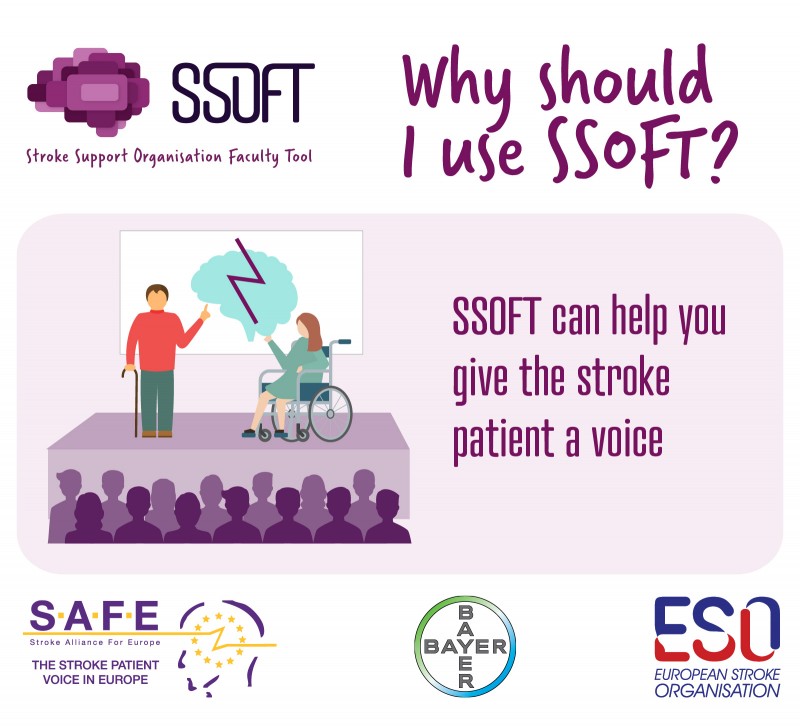Brussels, 21st November 2018 – As the second biggest killer in the world, the response to Stroke needs an army of advocates to ensure the message that it is preventable, treatable and beatable is implemented. SSOFT is an excellent tool to educate people on the principles of stroke advocacy. It will strengthen their ability to advocate for better stroke prevention, treatment and after care. This module is vital as a contribution to effective public campaigning. We believe that SSOFT will provide inspiration for future stroke advocates to make a real-life change, says Jon Barrick, SAFE President.
The sixth and final eLearning module of the Stroke Support Organisation Faculty Tool (SSOFT) is published today at the following address www.ssoft.info, thus marking the completion of this innovative eLearning tool on stroke support organisation and the principles of stroke advocacy.
The SSOFT’s sixth module focuses on the skills and principles around developing effective public advocacy campaigns.
SSOFT’s development and execution was successfully led by Victoria Brewer, SAFE Project Director, who stressed from the beginning of the project that the members of the SAFE had to be central to the whole process. SAFE members have been actively involved in the development of the content by either testing the modules, providing cases studies or sharing their experience in interviews. These examples have brought much of the content to life by providing real world cases studies of how the knowledge contained in the modules can be applied.
“The opinion of the people who test the program [has been] important. Therefore, SSOFT is exactly what should be: a tool ‘for our members by our members’.” Nenad Nikolić Moždani Udar, the Serbian Stroke Association
The release of the final module marks a significant stage in SSOFT’s development with this stage of development being completed. SAFE is currently exploring future expansion options for SSOFT
“I hope that the tool will never be truly “finished” but remain a live environment that always adapts to the latest developments and experiences.” André de Rosa Spierings, National Board member of Hersenletsel, Netherlands.
About SSOFT’s 6th module
SSOFT’s sixth module focuses on the skills and principles around developing effective public advocacy campaigns. The module is broken down in to five bitesize sections, which cover:
6.1 Public advocacy – focuses on the role of public engagement in advocacy & how to dispel stroke myths to drive change.
6.2 Stroke Community & Mass Campaigning – covers how to build a stroke community & campaign to a large audience
6.3 Publicity – demonstrates how to manage publicity by engaging with print & broadcast media
6.4 Traditional Media – helps learners to understand the role of traditional media &and learn how to work with journalists & editors
6.5 Social Media – examine the role of social media in bringing momentum for change.
About SSOFT
SSOFT is an innovative online eLearning advocacy tool being developed by Stroke Alliance for Europe (SAFE), in partnership with the European Stroke Organisation (ESO).
“I think this is just the beginning; …. I envisage this resource as further strengthening the European stroke patient network and in time the global stroke patient network.” @BelsonSarah
This online learning platform provides knowledge and training on how the creation of effective advocacy activities and campaigns to deliver positive change at a local and national level on stroke prevention, treatment and care. The eLearning platform includes six modules that provide information on:
Module 1: Stroke Support Organisations (SSOs)
Module 2: Making Change Happen
Module 3: Use of Evidence
Module 4: Role of Patient Voice
Module 5: Health & Care System Advocacy
Module 6: Public Advocacy
The modules and learning environment are accessible via the SSOFT website through a simple registration process. Visitors to the website can also learn more about SSOFT, SAFE and ESO, find their nearest SAFE Stroke Support Organisation (SSO) as well as hear from SAFE members about their experiences.
For more information, please send an email ssoft@safestroke.eu or visit www.ssoft.info
Acknowledgments
SAFE would like to take this opportunity to thank and acknowledge the contributions made by those who have helped in the development of SSOFT and module 6.
Stroke Alliance for Europe Board, who have been involved at every stage of development of this module.
The Peer Reviewers for module 6:
- Stiftung Deutsche Schlaganfall-Hilfe (Dr Markus Wagner)
- World Stroke Organization (Anita Wiseman)
- Irish Heart Foundation (Chris Macey)
- Different Strokes Charity (Austin Willets)
- Hellenic Alliance/Action for Stroke Support Organization (Dr Hariklia Proios)
- Macedonian Stroke Association (Dr Anita Arsovska)
Our members who have shared their experiences and knowledge in the video interviews used within the module:
- Adam Siger – Fundacja Udaru Mózgu, Poland
- Anita Arsovska – Macedonian Stroke Association
- Chris Macey – The Irish Heart Foundation, R.Ireland
- Hrvoje Jurlina – HDPMU Croatian Stroke Society, Croatia
- Francesca Romana Pezzella – ALICe, Italy
- Jon Barrick – Stroke Alliance for Europe (SAFE)
- Mara Cochetti – ALICe, Italy
- Nenad Nikolić – Moždani Udar, Serbia
- Pnina Rosenzweig – Neeman Association for Stroke Survivors, Israel
Our member and partner organisations who have collaborated in the development of the module content:
- World Stroke Organization
- European Stroke Organisation
- Stroke Association UK
And all those who participated in the User Acceptance Testing of module 6.
We would also like to thank the project sponsor Bayer Healthcare who have supported this project through an education grant.
About SAFE
The Stroke Alliance for Europe (SAFE) a non-profit-making organisation formed in 2004. It is the voice of stroke patients in Europe, representing a range of patient groups from 30 European countries.
SAFE’s goal is to decrease the number of strokes in Europe by advocating for better prevention, access to adequate treatment, post-stroke care and rehabilitation.





